Homemade Breakfast Sausage Recipe (Links or Patties)
This post may contain affiliate links. See my disclosure policy.
Nothing beats homemade and homemade breakfast sausages are no exception! Tender, moist, and wonderfully flavorful, this homemade breakfast sausage recipe is entirely from scratch without any fillers or junk ingredients and I think you’ll agree that they’re the best sausages you’ve tasted!
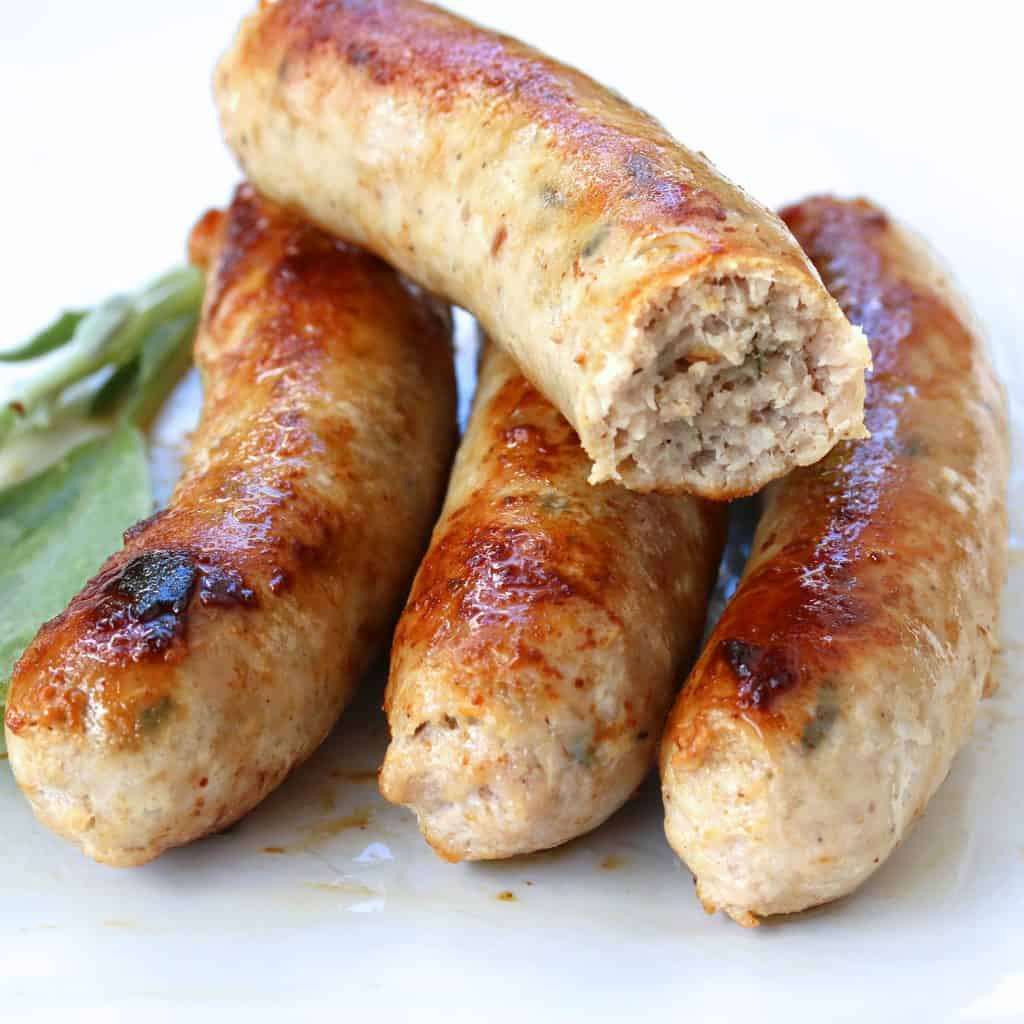
Why I Love This Breakfast Sausage
Truly nothing beats the quality and flavor of homemade breakfast sausage! Not only do they taste better, you know exactly what’s in them and what isn’t. You have full control over the quality of the ingredients that go into making them and good choices always pay off in the end.
Charctuterie-making has been a hobby of mine for several years now. I started off with the simple art of making fresh sausages like these homemade breakfast sausage links and then started making my own bacon and Canadian bacon. Eventually I graduated into making the more complicated forms of charcuterie, namely fermented and dry-cured meats including salami, pepperoni, coppa and pancetta.
While dry-cured meats require the utmost precision, care and monitoring (not to mention additional specialized equipment), fresh sausages on the other hand are not only super easy to make, they’re also a lot of fun! When I make sausages I usually like to make the effort of pulling out the meat grinder and sausage stuffer worth it, so I make a bulk batch that I can freeze – then I can conveniently pull them out and throw them in the frying pan as needed.
These breakfast sausages are a favorite staple in our home. We regularly pick up ground pork from a local farmer down the road and make a large batch of these to freeze to have on hand. Whether you’re already an experienced sausage-maker or are just getting started, you’re going to LOVE this easy homemade breakfast sausage recipe!
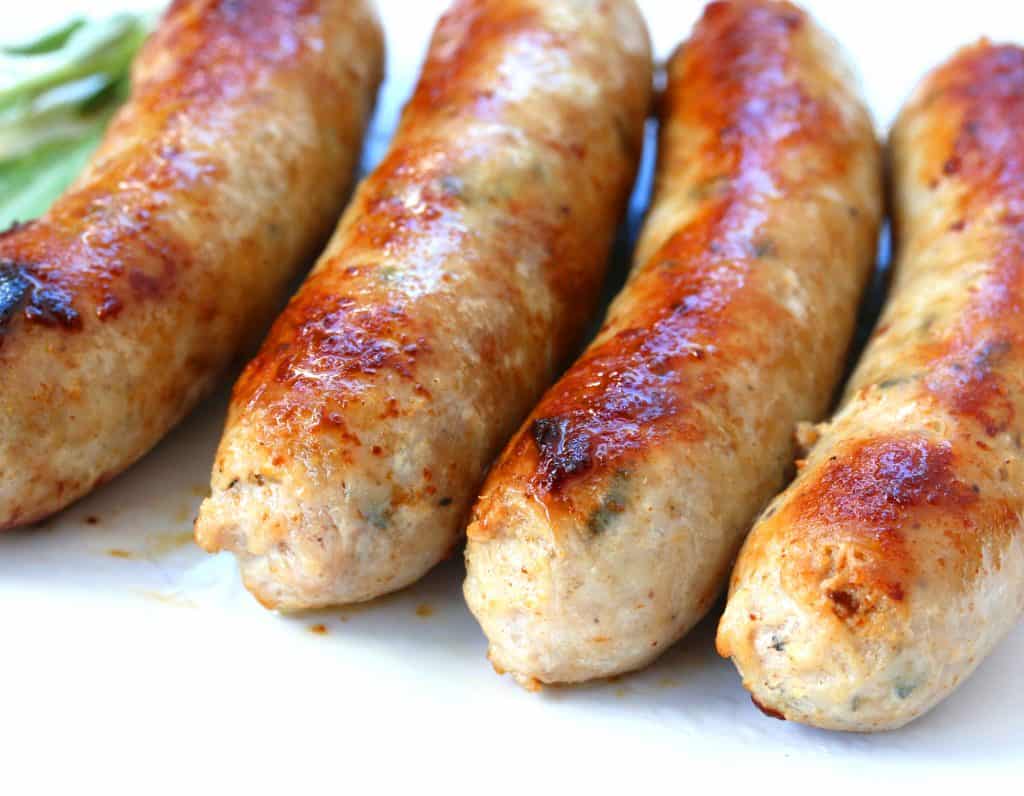
Sausage Making Resources
Before we get started on this breakfast sausage recipe I want to share a few helpful resources with you. Once you get the basics down on how to make sausages, you can create your own flavors and combinations which is what I particularly enjoy doing. But having one or two good books to learn and practice from is a a must. I have combed through many books on charcuterie and sausage-making over the past few years and these ones continue to be my favorites:
Great Sausage Recipes and Meat Curing by Kutas is a classic and one of the first comprehensive books written on the subject. It’s a no-nonsense, straight-forward book packed full of recipes. Charcuterie: The Craft of Salting, Smoking and Curing by Ruhlman has likewise been a very popular book. The current edition is revised and updated. I have the previous edition and there are inaccuracies and errors in it that the newest edition has reportedly fixed, but I still hear complaints about it. Nevertheless, I like this book as a source of inspiration for some great recipes. Olympia Provisions: Cured Meats and Tales from an American Charcuterie is the newest kid on the block and it is both a fun and inspiring read. The author, Elias Cairo, is the founder of Olympia Provisions in Portland Oregon and owns several restaurants and butcher shops there. This book features several of his most popular recipes. The recipes are very well crafted and you’ll love the end results.
The final two books are both written by Stanley & Adam Marianski: The Art of Making Fermented Sausages and Home Production of Quality Meats and Sausages. While these are a very dry read, definitely not packed with inspirational stories or beautiful photographs, I consider these indispensable to anyone who is serious about wanting to learn the art of charcuterie and sausage-making. Consider them the most comprehensive how-to manuals on the market. There is not a single question that isn’t answered in these books. Especially if you are planning on dabbling in dry-cured meats, The Art of Making Fermented Sausages is a MUST.
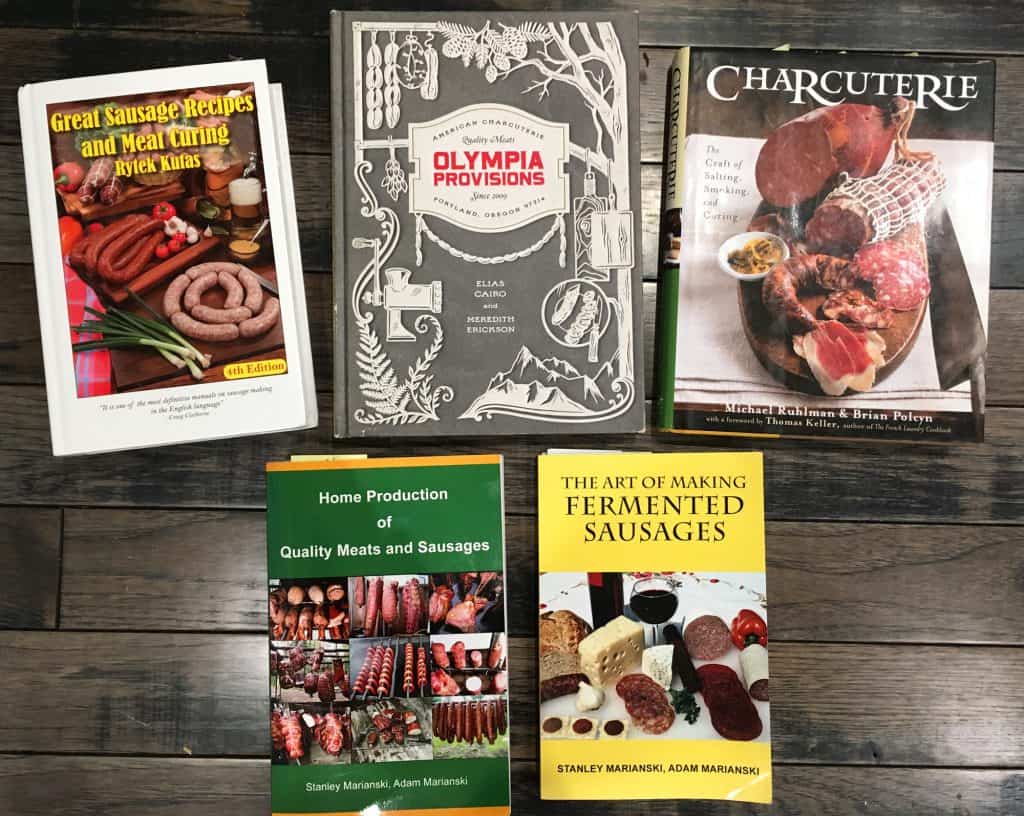
Breakfast Sausage Recipe
Let’s get started!
Note About Making Breakfast Sausage Patties: The pictures below show the process of stuffing the breakfast sausage meat into casings to make breakfast sausage links. If you prefer, you can skip the stuffing process and make patties instead. I do it all the time! Instructions are provided below.
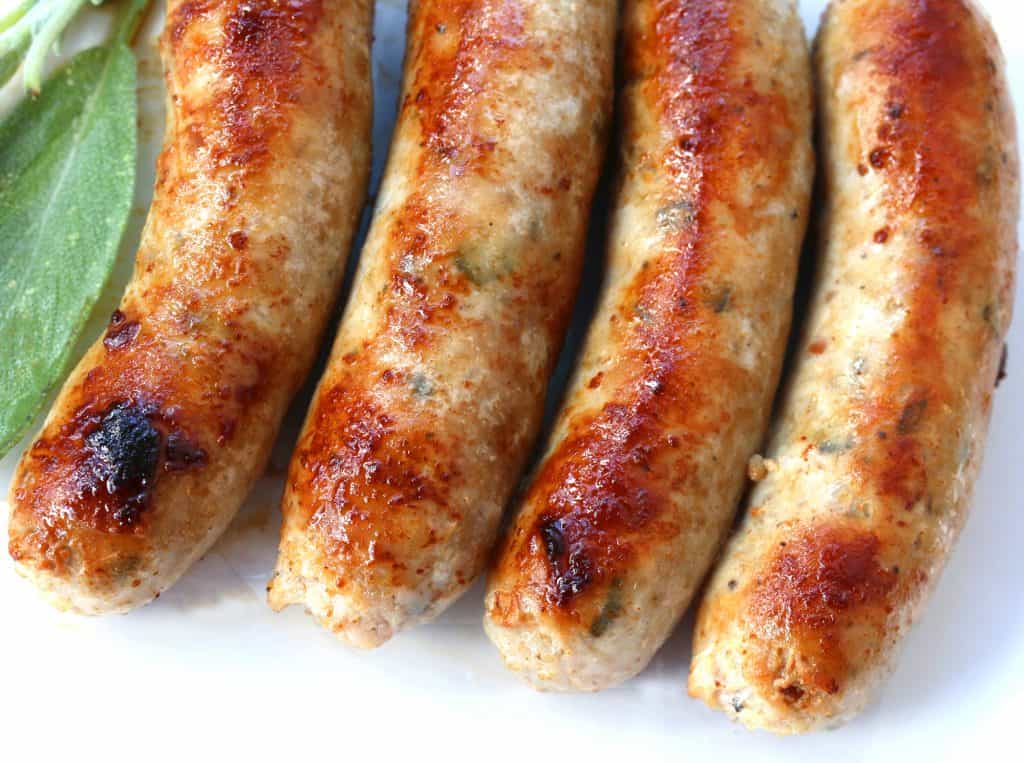
Cut the pork butt into 1/2 inch chunks and freeze them for about 45 minutes to get them to a temperature of 32 degrees F (0 celsius). (See note in recipe box below for explanation as to why keeping the meat is so critical.)
Grind the pork through a 1/4 inch (6mm) die. Grind the meat quickly into the bowl of a stand mixer (ideally have the bowl set atop an ice bath to keep the meat cold) and then grind it all a second time. Chill the meat in the refrigerator while you assemble the spice mixture.
I use the STX International Turbo Force Electric Meat Grinder. With 3000 watts, 3 speeds and a 3-year warranty, it has high reviews and comes top recommended by most review sites as the best bang for the buck.
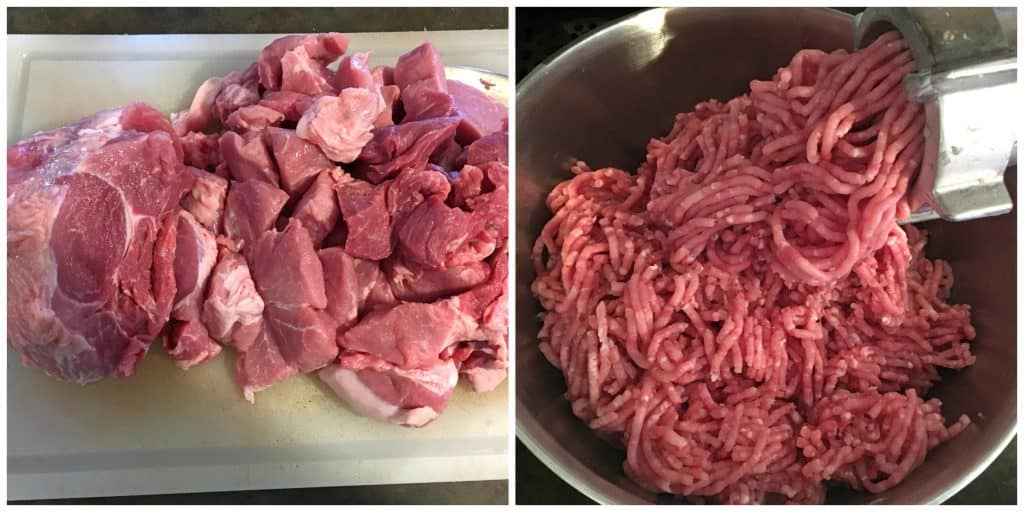
In a bowl combine the salt, sage, thyme, ginger, white and black pepper, garlic and nutmeg.
Remove the ground meat from the fridge and place it on the stand mixer fitted with a paddle attachment. Add the spice mixture and the ice water.
Note: For variation you can add 1 cup of maple syrup for sweeter Homemade Maple Breakfast Sausages.
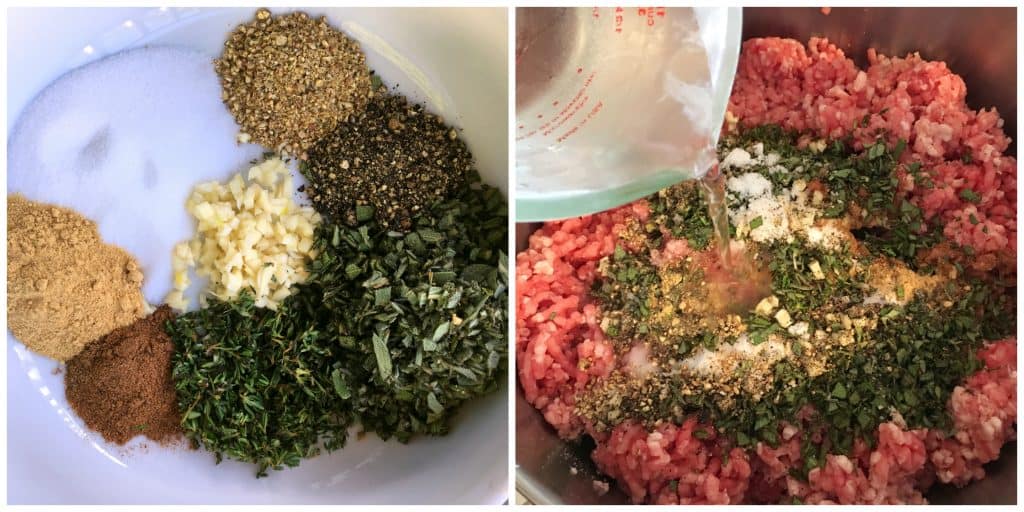
If you have room in your freezer, pre-chill the mixing bowl.
Mix the meat mixture with the paddle for 3-4 minutes until threads begin to appear in the meat: If you take a clump of meat and pull it apart with your fingers you will see tiny threads pulling apart – see pic below on right.
Chill the mixture in the fridge while you prepare the sausage stuffer. Take a bit of the meat mixture, fry it up, taste it and adjust the seasonings if needed.
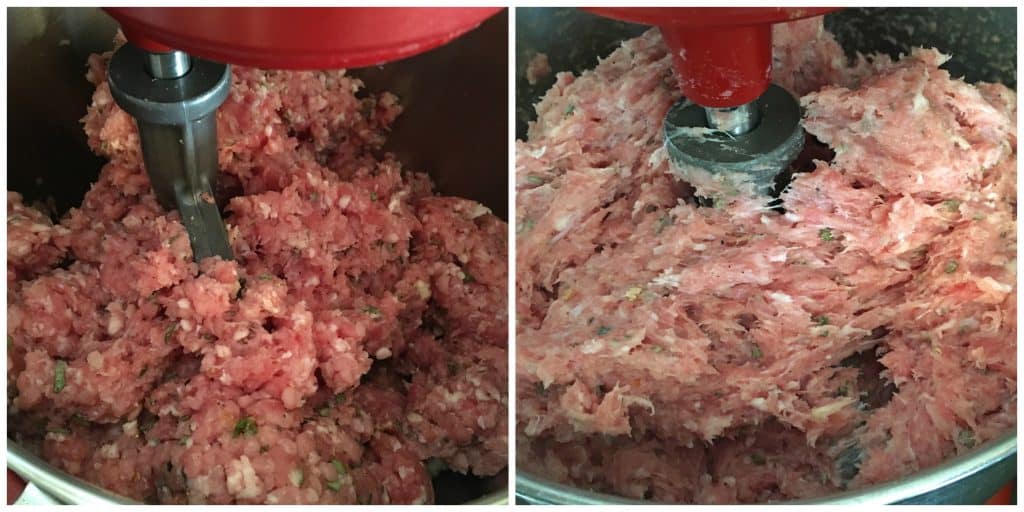
I use the Super Deal Heavy Duty 5L Vertical Sausage Stuffer and am happy with it. We very carefully researched the sausage stuffers on the market and specifically chose this one because of it’s large capacity and 100% metal construction (no plastic parts = not breakable) and because it’s easy to clean.
Thread the sausage stuffer with the prepared sheep casings, fill the sausage stuffer with the meat mixture, and fill the casings being careful to avoid air gaps while also not overstuffing the casings.
Note: Sheep casings are more challenging to work with than hog casings and they take getting used to. Be sure to keep them wet at all times and use a sufficiently small stuffing tube.
Note About Making Breakfast Sausage Patties: You can skip the stuffing process and make sausage patties instead. Simply take some of the sausage mixture in your hands, form it into a ball, press it between your palms into a patty, lay it on a lined cookie sheet and repeat, layering the patties with more parchment or wax paper to keep them from sticking to each other. Then freeze for a few hours and transfer the patties into a freezer container or ziplock bag to use as needed.
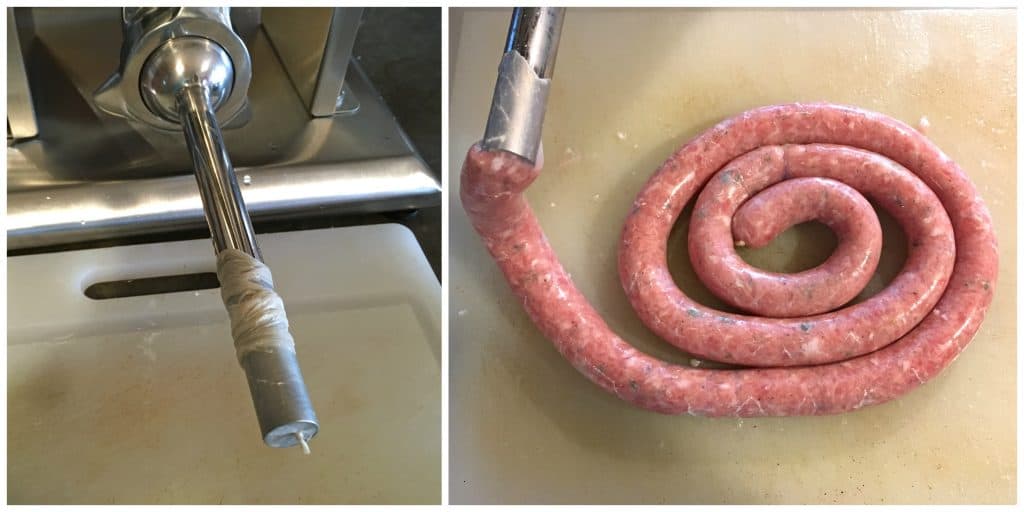
Twist the sausages into links. Use a sausage pricker to prick any air bubbles out of the links.
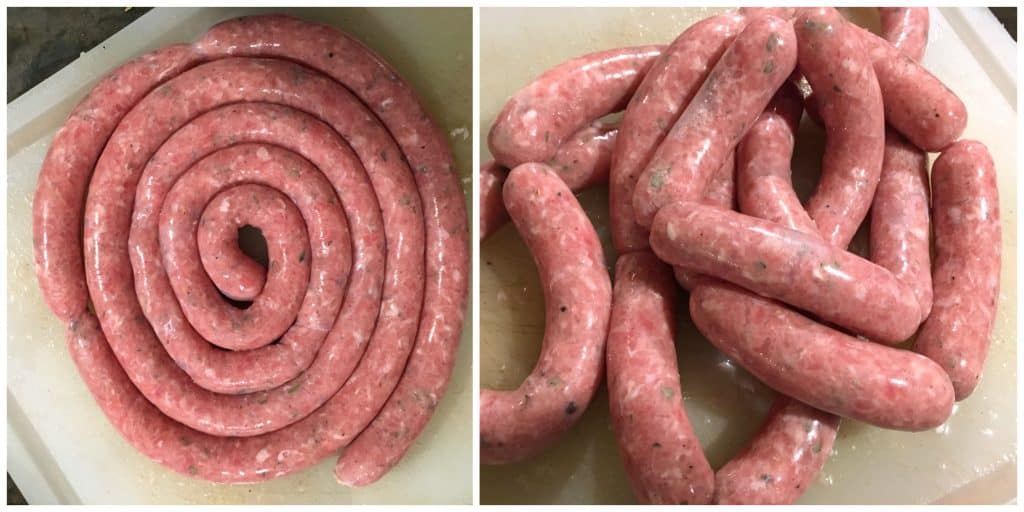
Now that the sausages are done you have two options: Cook the sausages by heating up some oil in a frying pan and frying the sausages on each side for about 3 minutes until browned and done in the middle (internal temperature of 155 degrees F).
OR you can poach the sausages (do not boil) in lightly salted water until their internal temperature reaches 155 degrees F, then let them cool in ice water, wrap them and store in the fridge for up to a week or in the freezer for up to 2 months.
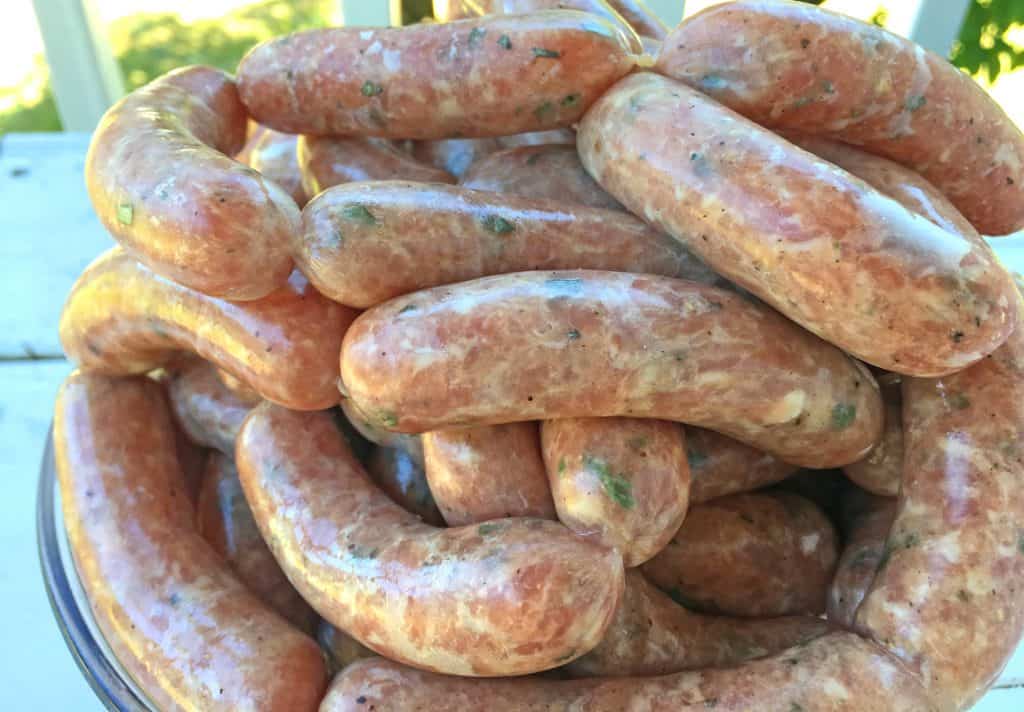
Enjoy!
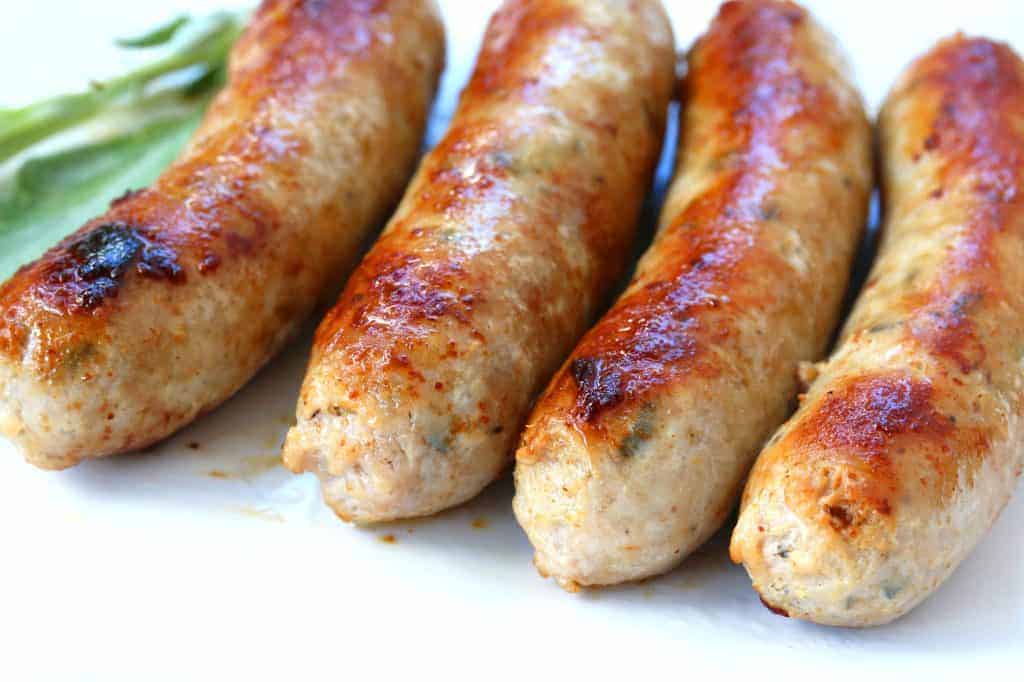
For more adventures in DIY charcuterie be sure to try my:
- Italian Sausage Recipe
- Homemade Mexican Chorizo
- Homemade German Bratwurst
- Homemade British Bangers
- Smoked Ham Hocks
- How to Smoke a Ham
- Smoked Cheddar Sausages
- Italian Capicola
- How to Make Bacon
Save This Recipe
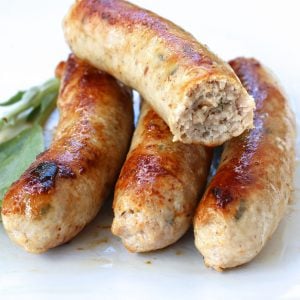
Homemade Breakfast Sausage Recipe (Links or Patties)
Ingredients
- 10 pounds boneless pork butt/shoulder (this cut is recommended for the right ratio of lean meat to fat) (can substitute 10 pounds of ground pork if you don't want to grind your own)
- 3/4 cup chopped fresh sage , or 1/4 cup dried rubbed/ground sage
- 1/4 cup chopped fresh thyme , or 2 tablespoons dried
- 5 tablespoons sea salt
- 2 1/2 tablespoons ground ginger
- 1 1/2 tablespoons freshly ground white pepper
- 1 1/2 tablespoons freshly ground black pepper
- 2 1/2 tablespoons minced fresh garlic
- 1 tablespoon ground nutmeg
- 3/4 cup pure maple syrup (optional)
- 2 cups ice water
- Natural sheep casings (3/4 inch/20 mm, about 30 feet), soaked and thoroughly rinsed
Instructions
- Cut the pork into 1/2 inch chunks and freeze them for about 45 minutes to get them to a temperature of 32 degrees F (0 celsius). Grind the pork through a 1/4 inch (6mm) die. Grind the meat quickly into the bowl of a stand mixer (ideally have the bowl set atop an ice bath to keep the meat cold) and then grind it all a second time. Chill the meat in the refrigerator while you assemble the spice mixture.In a bowl combine the salt, sage, thyme, ginger, white and black pepper, garlic and nutmeg.
- Remove the ground meat from the fridge and place it on the stand mixer fitted with a paddle attachment. (If you have room in your freezer, pre-chill the mixing bowl.) Add the spice mixture and the ice water and the maple syrup if using. Mix it with the paddle for 3-4 minutes until threads begin to appear in the meat (if you take a clump of meat and pull it apart with your fingers you will see tiny threads pulling apart). Chill the mixture in the fridge while you prepare the sausage stuffer. Take a bit of the meat mixture, fry it up, taste it and adjust the seasonings if needed.
- If making sausage patties: scoop some of the mixture into your hands and roll it into a ball (about the size of a golf ball or slightly bigger), then press it down into a patty. These can be layered on a cookie sheet with plastic wrap or wax paper between the layers, frozen, and then transferred to a ziplock freezer bag or container. If making sausage links:Thread the sausage stuffer with the prepared sheep casings, fill the sausage stuffer with the meat mixture, and fill the casings being careful to avoid air gaps while also not overstuffing the casings. Twist the sausages into links. Use a sausage pricker to prick any air bubbles out of the links.
- Cook the sausages by heating up some oil in a frying pan and frying the sausages on each side for about 3 minutes until browned and done in the middle (internal temperature of 155 degrees F). OR you can poach the sausages (do not boil) in lightly salted water until their internal temperature reaches 155 degrees F, then let them cool in ice water, wrap them and store in the fridge for up to a week or in the freezer for up to 2 months.
Notes
Nutrition
Originally published on The Daring Gourmet January 8, 2018



















I did not care for the garlic flavor. The texture, spices, and herbs were a nice blend, but I think my mixture was to lean and could have use more fat. I used a pork butt with lots of fat, but something was just missing in the flavor. I added the maple syrup too as instructed, but still felt like something was missing. I buy my fresh country sausage from the Fresh Market Grocery Store chain which is made fresh daily on site here in South Carolina. There is an art in making sausage and sausages! I need more practice to get that great taste!
These are really good sausages with exactly the right amount of spice and herb. Highly recommended and thanks for sharing.
Just tried this recipe and it was so good the wife and I stopped making sausage and made breakfast as soon as we tried a little bit for flavor testing.
That’s wonderful, Kenny, thank you so much!
I was just wondering (if proper adjustments were made) if i could use dry spices instead of fresh chopped??
Hi Sally, yes you can.
I have the all metal kitchenaid grinder and sausage stuffer, no plastic. Have you had problems with this? I find it okay. I am going to make your recipie today.
Hi Gareth, that’s what I’ve used in the past as well. It will work for small batches.
I just bought 2 Boston butts my local IGA had them for 89 cents a pound.I will be trying this recipe tomorrow.If anyone that loves to make fresh sauage cure meats,and cold smoking meats I suggest that you join this Facebook Group its call Cold Smoking Curing and Sausage Making.There is a lot of great information and a lot of people in this group have great knowledge of this and they are willing to help and share there knowledge.Here is a link to the Facebook page.https://www.facebook.com/groups/meatcuringandsmoking/
Thanks for the swift and detailed reply :)
Hi, great to see a sausage recipe without Prague salt, nitrates/nitrite additives etc – so many recipes try to scare you half to death if you don’t include them. Is there a reason why you don’t? I feel I’m very careful hygiene-wise in the kitchen dealing with raw meats etc and would never think of storing uncooked meat products anywhere other than in the fridge at a suitable temperature, so can’t understand their fixation. Also, l’d either be cooking the sausages within a day or freezing them immediately, which brings me to my second question – why do you poach them before freezing rather than freezing the uncooked product straight away? Many thanks
Hi Brantome, great questions. To answer your first question, I do use “pink salt” for some things – for example, for meats and sausages that I smoke I use pink salt #1/Prague powder because during the long and slow smoking process, the temp of the meat is being brought down into the “danger zone” for a long period of time where bacteria can form. The pink salt is a precautionary measure that safeguards the meat from unwanted bacteria. It also serves an aesthetic purpose in preserving the color of the meat (think bacon that is an unsightly gray/brown color).
I use pink salt #2 when I’m dry-curing meats and sausages – hanging raw meat up to dry for months at a time (e.g., salami, pancetta, proscuitto, etc). That is likewise to prevent bad bacteria, such as botulism, from forming and it also maintains the pink/red color of the meat.
On the subject of nitrates/nitrates, the “scare” you mentioned goes both ways – people trying to scare you if you don’t use it AND people trying to scare if you if you do use it. There is a lot of misunderstanding and myth out there. Even supposed “nitrate free” products in the stores still have nitrates. If you look closely at the ingredients you’ll see “celery salt” which is exactly what that is. It’s a FDA loophole. Nitrates/nitrites are safe to use when they’re used correctly. That means using the right pink salt for the right purpose, using exactly the right amount, and preparing/cooking the sausages correctly. You can find more details about this subject online where there is a ton of information available.
For fresh sausages, like these breakfast links, they are neither smoked nor dry-cured, they are stuffed, cooked and eaten, so from a bacteria standpoint there is no risk (provided you work quickly during the grinding/stuffing process to prevent the temperature of the meat from getting too low). Some people still use pink salt #1 for fresh sausages simply to preserve the color. That just comes down to personal preference.
Poaching before freezing: Poaching (very gentle simmer) is done instead of boiling to prevent the fat from rendering, preserving the texture. You don’t have to poach before freezing, I do it as a matter of convenience so all I have to do is grab the frozen/already cooked sausages, let them thaw, and give them a quick sear before eating.
Hope this answers your questions! Best, Kimberly
These are the best home made sausages I’ve ever had and the best ones I’ve made my self. My kids had a blast yesterday. Everyone loved them even my husband. I was shocked when he said “I Don’t know what your doing but keep doing it.” lolz
Amy Jackeel
Washington
Wahoo! I’m thrilled to hear that, Amy, thank you!
Have made this. Awesome recipe. Family loves them. Thanks Marcy
Fantastic, Marcy, thanks so much!
These look amazing! Have you also got a pure beef sausage recipe ?(no grains or fillers)? Cheers maree
Thanks, Maree! Yes, I have more sausages recipes on the way, including beef sausages :)
Looks very tasty. Will be trying it at home.
Wow! This is impressive, I have never even considered making my own sausages and dry-cured meats. Amazing! The sausages look exactly like the Bratwurst I can buy at the butcher’s around here!
Thanks, Adina! You’re fortunate where you live in that you have access to the very best sausages and dry-cured meats in the world :) But it’s been very rewarding making my own, it really is fun.
I had no idea how easy this actually is.
What is ‘pork butt’? I’ve always used pork shoulder.
Hi Mary, they’re the same thing known by different names.
Oh my gosh.I was born and raised in Lincolnshire,England and the sausages made there were famous and how I miss them.This is very much like them and I thank you so much
Wonderful, Ann! Yes, the dominating sage and pepper is very characteristic of Lincolnshire sausages and once you add some rusk/breadcrumbs and very coarsely grind the pork (instead of finely ground like I did here), it’s very similar indeed. Another one of my favorite sausages are British bangers and I’ll be posting my recipe for those in the near future also :) By the way, we’re taking our kids on a family vacation to England for 3 weeks this year and will be touring every county along with some stops in Wales and Scotland. I’m homesick and can’t wait to go back for a visit.
Lucky you.I spent 2 weeks there in September and ate so many Melton Mobray pork pies,I was in heaven!.Have a great trip.